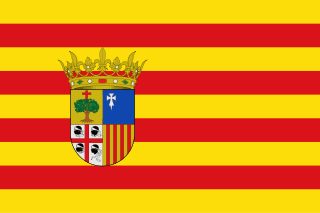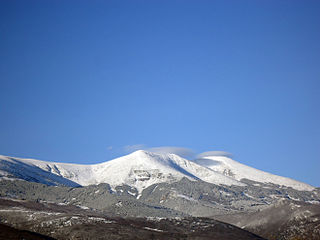
The Sierra de Gredos is a mountain range in central Spain that spans the provinces of Ávila, Salamanca, Cáceres, Madrid, and Toledo. It is part of the much larger Sistema Central of mountain ranges. Its highest point is Pico Almanzor, at 2,592 metres and it has been declared a natural park by the Autonomous Community of Castile and León. The Sierra de Gredos is one of the most extensive mountain ranges of the Central System; it comprises five river valleys: the Alto Tormes, the Alto Alberche, the Tiétar Oriental, the Tiétar Occidental y la Vera, and the Valle del Ambroz. The first known inhabitants were the Vettones, a pre-Roman Celtic people. The central part of the range encomprises the Sierra de Gredos Regional Park.

Abejuela is a municipality located in the province of Teruel, Aragon, Spain. According to the 2004 census (INE), the municipality has a population of 68 inhabitants. It is the southernmost town in Aragon.

Aitana is a mountain massif that is part of Prebaetic System in the eastern end of the Iberian Peninsula. Administratively, the mountainous area is located in the Marina Baixa, Alcoià and Comtat comarcas in the northern part of Alicante province, Valencian Community, Spain. Its peak at 1,558 metres above sea level is the highest point of the province.
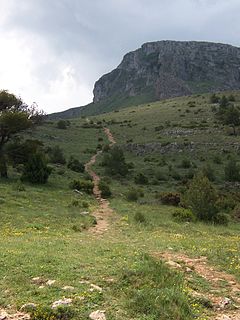
The Serra Mariola Natural Park is a mountain range in the Valencian Community, Spain, one of the most peripheral offsprings of the Baetic System. Most if its territory is included in a natural park founded in 2002, covering an area of 17,257 ha.

Maestrazgo is a comarca in southeastern Aragon, Spain. Its names derives from the Maestrat/Maestrazgo mountain massif that extends to the east to the Comarques of the Valencian Community Alt Maestrat and Baix Maestrat. The most important town is Cantavieja. It is bordered by the Aragonese comarcas of Andorra-Sierra de Arcos, Cuencas Mineras, Comunidad de Teruel and Bajo Aragón, in the north and in the west and Gúdar-Javalambre in the south, as well as with the Castellón Province in the east. Some municipal terms of this comarca are part of the historical region of Lower Aragon.
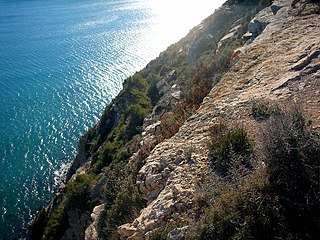
Serra d'Irta is an 18.8 km long mountain range in the Baix Maestrat comarca, Valencian Community, Spain. Its highest point is Pic Campanilles.

Penyagolosa is a mountain in the Alcalatén area, Valencian Community, Spain. Geologically it is part of the Iberian System, located at the eastern end of Iberian Peninsula. Its peak is at 1,813 meters above sea level and is often crowned with snow in the winter.
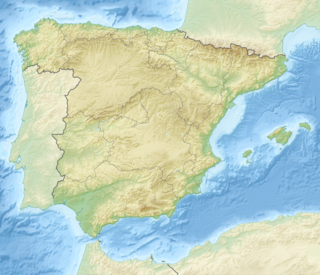
Serra de Sant Pere or Serra del Solà is a 5.8 km (4 mi) long mountain range in the Baix Maestrat comarca, Valencian Community, Spain. Its highest point is Tossal de Sant Pere. The slopes are covered in low Mediterranean vegetation

Sierra de Orihuela is a 9.4 km (6 mi) long mountain range in the Vega Baja del Segura comarca, Valencian Community, Spain. Its highest point is Peña de Orihuela. This range is named after the town of Orihuela, located at the feet of the mountains. The western end of the range is within the limits of the Santomera municipal term, in the Region of Murcia.

Sierra del Mugrón is a 16.6 km (10 mi) long mountain range located between the Valle de Cofrentes comarca, Valencian Community, and Almansa, Castile-La Mancha, Spain. It is an isolated range between the Iberian System and the Cordillera Prebética. Its highest point is 1,209 m. The northern section of this range is within the Ayora municipal term, while the southern belongs to Almansa.

Serra d'Espadà is a 51 km (32 mi) long mountain range in the Alt Palància, Alt Millars and Plana Baixa comarcas, in the Province of Castellón, Valencian Community, Spain. Its highest point is La Ràpita.

Sierra de Utiel is a 16.45 km (10 mi) long mountain range in the Alt Palància, Alt Millars and Plana Baixa comarcas, Valencian Community, Spain. Its highest point is the 1,306 m high El Remedio. There is often snow in the winter.

Serra Calderona, often referred to as La Calderona is a 49 km (30 mi) long mountain range in the Camp de Túria, Horta Nord and Alt Palància comarcas of the Valencian Community, between the provinces of Castelló and Valencia Spain.

Serra de Vallivana or Muntanyes de Vallivana is an over 14 km (9 mi) long mountain range straddling the Alt Maestrat and Baix Maestrat comarcas, Valencian Community, Spain.

Sierra de Gúdar is a mountain range in the Gúdar-Javalambre and Maestrazgo comarcas of Aragon and the Alto Mijares comarca of the Valencian Community, Spain. The highest point in the range is Peñarroya (2,019 m).

Serra de d'Esparreguera or Serra Esparreguera is an over 17 km (11 mi) long mountain range in the Alt Maestrat comarca, Valencian Community, Spain.

Serra de la Valldàngel or Serra de la Vall d'Àngel,, is a mountain range in the Baix Maestrat comarca, Castellón Province, Valencian Community, Spain.
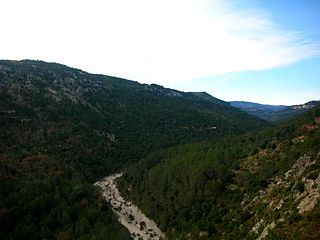
Serra del Turmell, also known as Serra del Mont Turmell, is an over 12 km (7 mi) long mountain range in the Baix Maestrat comarca, Valencian Community, Spain.

